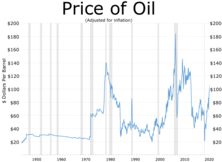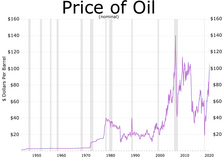
Back وفرة النفط في الثمانينيات Arabic Caída de los precios del petróleo en los años 1980 Spanish مازاد نفت دهه ۱۹۸۰ Persian Contre-choc pétrolier French Banjir minyak 1980-an ID 1980년대 석유 공급과잉 Korean Перепроизводство нефти в 1980-х годах Russian Презасићеност нафтом 1980-их Serbian Перевиробництво нафти у 1980-х роках Ukrainian

The 1980s oil glut was a significant surplus of crude oil caused by falling demand following the 1970s energy crisis. The world price of oil had peaked in 1980 at over US$35 per barrel (equivalent to $129 per barrel in 2023 dollars, when adjusted for inflation); it fell in 1986 from $27 to below $10 ($75 to $28 in 2023 dollars).[2][3] The glut began in the early 1980s as a result of slowed economic activity in industrial countries due to the crises of the 1970s, especially in 1973 and 1979, and the energy conservation spurred by high fuel prices.[4] The inflation-adjusted real 2004 dollar value of oil fell from an average of $78.2 in 1981 to an average of $26.8 per barrel in 1986.[5]
In June 1981, The New York Times proclaimed that an "oil glut" had arrived[6] and Time stated that "the world temporarily floats in a glut of oil".[7] However, The New York Times warned the next week that the word "glut" was misleading, and that temporary surpluses had brought down prices somewhat, but prices were still well above pre-energy crisis levels.[8] This sentiment was echoed in November 1981, when the CEO of Exxon also characterized the glut as a temporary surplus, and that the word "glut" was an example of "our American penchant for exaggerated language". He wrote that the main cause of the glut was declining consumption. In the United States, Europe, and Japan, oil consumption had fallen 13% from 1979 to 1981, "in part, in reaction to the very large increases in oil prices by the Organization of Petroleum Exporting Countries and other oil exporters", continuing a trend begun during the 1973 price increases.[9]
After 1980, reduced demand and increased production produced a glut on the world market. The result was a six-year decline in the price of oil, which reduced the price by half in 1986 alone.[2]
- ^ "Crude Oil Prices – 70 Year Historical Chart". MacroTrends. Retrieved 25 May 2022.
- ^ a b Cite error: The named reference
NYTwas invoked but never defined (see the help page). - ^ Mouawad, Jad (8 March 2008). "Oil Prices Pass Record Set in '80s, but Then Recede". The New York Times. Retrieved 20 April 2010.
- ^ "Oil Glut, Price Cuts: How Long Will They Last?". U.S. News & World Report. Vol. 89, no. 7. 18 August 1980. p. 44.
- ^ Oak Ridge National Lab data[dead link]
- ^ Hershey Jr., Robert D. (21 June 1981). "How the Oil Glut Is Changing Business". The New York Times. Retrieved 30 December 2015.
- ^ Byron, Christopher (22 June 1981). "Problems for Oil Producers". Time. Archived from the original on 5 January 2013. Retrieved 19 January 2008.
- ^ Yergin, Daniel (28 June 1981). "The Energy Outlook; Lulled to Sleep by the Oil Glut Mirage". The New York Times.
- ^ Garvin, C. C. Jr. (9 November 1981). "The Oil Glut in Perspective". Oil & Gas Journal. Annual API Issue: 151.
© MMXXIII Rich X Search. We shall prevail. All rights reserved. Rich X Search

